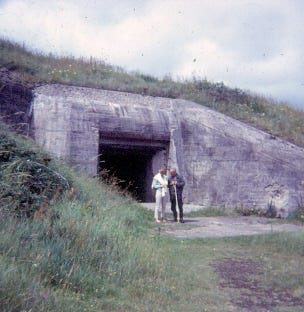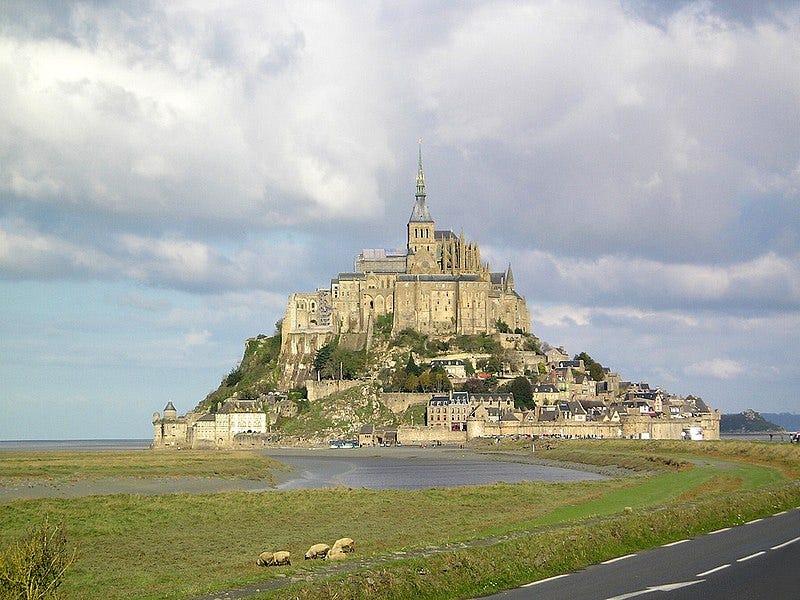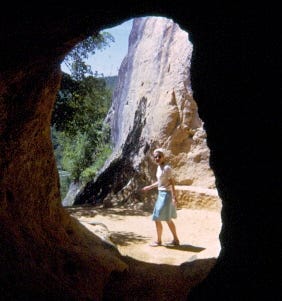A summer in Europe
It was the summer of 1966. I had just completed my master’s degree at the University of Vermont, and Barbara finished a year teaching French at Montpelier High School. We would be heading off to Michigan where I had been admitted into the doctoral program that coming Fall.
We decided to spend most of the summer in Europe, primarily France, since Barbara knew a great deal about the country’s geography, history, art, and language. Things she studied extensively as an undergraduate. At the time, travel on Icelandic Airlines was a must as their round trip fares were well below any other offers. The plane was based at LaGuardia in New York. It made the first leg to Iceland with a two hour layover, and then directly on to Luxembourg.
I recall having lunch at the arrivals terminal in Luxembourg and watching a server mix, by hand, a family-sized serving of steak tartare. The children of the family awaiting the meal then shoved fistfuls into their mouths and seemed to love it.
“We toured Luxembourg with the brother of Lotte Omes, the foreign exchange student in my high school class.” ~ Barbara
We had arranged to rent a car and schedule our own travel. We tried to get a 2CV, which was introduced in 1948 as a car that 'everyman' could afford, and stayed in production for 42 years, largely unchanged in appearance. It achieved its founders goal and millions were produced, and until very recently were a common sight on the roads in France. Unfortunately, when we arrived at the Hertz office, we were informed that they had none available. In its place they offered a Renault station wagon, a very small vehicle with about a 40 hp engine. It also had excellent gas mileage, although it was only capable of 50 mph—downhill, with a tailwind.
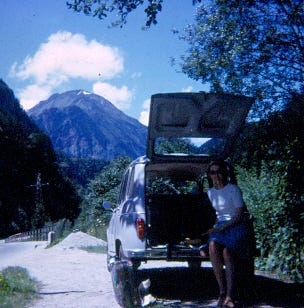
We picked the car up in Rheims, France, just outside the border with Luxembourg, and would return it there just before returning to the US again on Icelandic Airlines. When we asked on which side of the road it was proper to drive in southern France, we were told “whatever side is sunny.”
We used a popular guidebook called Europe on $5 A Day by Arthur Frommer for navigation. Traveling in our own vehicle was an alternative to RailPass, which might have been less expensive, but more limited. And we would have had to haul our luggage by hand and navigate congested urban railway stations. We had saved enough money to last most of the summer with final paychecks left behind and available when or if needed. It was probably only a few hundred dollars, but money in Europe at that time went a long way, so we felt confident about our finances.
Our first journey was south into Paris where we spend a week or so taking in the sights and sounds. Barbara had a former student whose grandmother lived in a lovely rooftop apartment in Paris, and we visited with her as a courtesy.
We stayed in a student hostel, or pension, on the Left Bank overlooking the Notre Dame Cathedral. The view out our window also overlooked the booksellers area, a famous feature of what was called the Latin Quarter, and we were within walking distance of a number of inexpensive restaurants and cafes. The Frommers guide was very helpful in identifying such places. While in Paris we visited the Eiffel Tower, including the elevator ride to the top.
“I had my hair done at the Galleries Lafayette and left wearing a hair piece.” ~ Barbara
We visited Napolean’s tomb; the Louvre Museum to see the Mona Lisa; the Tuileries Garden; the Champs-Élysées district with its famous department stores; the gravesite of Charles de Gaulle; and a day walking through Montmartre, a neighborhood high above the city with incredible views.
From there we drove west a short way to visit and tour the 17th Century Palace of Versailles, a former royal residence commissioned by King Louis XIV located in Versailles, about 11 miles (18 km) west of Paris, France. There is so much to see, and we took in as much as we could for a full day.
After that we headed further west toward Brittany, on the coastline of the English Channel. This is also close to the area targeted by the Western Allies during the European Invasion of World War II.
Brittany, France’s northwesternmost region, is a hilly peninsula extending out toward the Atlantic Ocean. Its lengthy, rugged coastline is dotted with beach resorts such as the chic Dinard and walled Saint-Malo, built on rock in the English Channel. The Pink Granite Coast is famed for its unusual, blush-hued sand and rocks. Brittany is known for its abundant prehistoric menhirs (a type of megalith).
“Next to the Riviera, sitting on a beach, we watched women workers replace their bras with swim tops then reverse back after their lunch time.” ~ Barbara
We also visited Mont Saint-Michel in Normandy, accessible at low tide. It is visited by more than three million people each year. Over 60 buildings within the commune are protected in France as historical monuments.
We stayed overnight in Dinard where I was introduced to a delicious meal of Coq au Vin, a stewed chicken concoction uniquely French.
Following our stay in western France, we headed for the southern coast and the city of Nice. The main route led to the Marseille region, but after a few days driving we ended up in Nice. Along the way we tried to visit the Lascaux caves, located in the Dordogne region near Montignac, but they were closed while under restoration. We found another location and toured a prehistoric cave.
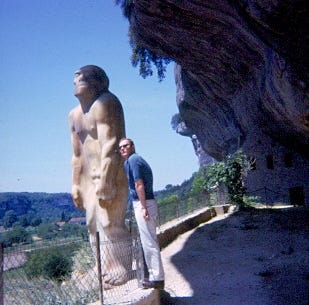
We also came upon a town with a horse stable, where the Republican Guard animals are raised and trained. And in another town we also saw a large group of bike riders getting organized for a junior-level Tour de France race. Later on, we were able to witness the actual Tour de France as it passed by on its third day after starting in Paris. I was stunned to learn that they rode well over 100 miles every day for two weeks.
During our stay in Nice, for about a week, we visited the nearby home sand studios of famous artists, including Picasso, Cezanne, Degas, Matisse, Renoir and Manet. We toured the town of Provence, the city of flowers and source of many brand named perfumes as well as the site of Vincent van Gogh’s attic painting. I bought my Aunt Elba a bottle of perfume.
We also had the luck of seeing the Fontaine du Soleil full of soap bubbles, and with Barbara’s coaching I managed to practice some basic French phrases at the cafes.
We made a side trip from Nice to Monaco, the home of Grace Kelly, who was married to the King of Monaco. We visited the famous Monte Carlo Casino where well-known and wealthy guests gambled.
Back in Nice, before leaving France and traveling south to Italy, we went to the local Western Union office to retrieve the remaining funds in our US bank. While there, a tall gentleman in full western garb, clearly from the U.S. and in all likelihood Texas, strode in and placed his briefcase on the counter. He instructed the clerk to produce his $500,000 payment in hundreds. It was quite obvious that he intended to spend some serious time at the Monte Carlo Casino. We stood by watching this scene while waiting for our $750 to be dispensed.
We got lost driving around Rome and ended up in the courtyard of the Presidential Quirinale Palace. Somehow Barbara managed an explanation in broken German with the Italian guards.
Later in Rome, we attended a Wednesday Mass at the Vatican and saw the Pope. We toured Michelangelo's statues and the Sistine Chapel. We traversed the Alps and visited Lugano and Bern in Switzerland.
“Back north through Germany, we drove on the Autobahn, passed by cars seemingly going 100 mph.” ~ Barbara
Heading through London, England, we stopped to see Buckingham Palace.
“In London we walked through water to our knees to see the Crown Jewels.” ~ Barbara
On our way to Scotland, we shared a ride to Aberdeen with the Agriculture Minister from Barbados (incidentally, Barbados gained independence within the British Commonwealth later that year). We walked our legs off on Aberdeen's granite streets and begged off to escape to a local movie theater for a nap and recovery.
When we departed Europe from Luxembourg, on time of all things, we were stuck in Iceland for 36 hours because the plane was in need of repair. We then landed in the U.S. during the 1966 International Association of Machinists strike against five airlines, which made reaching Boston a nightmare.

